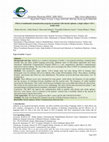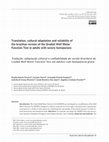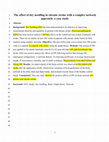Papers by noureddin nakhostin ansari
Journal of vessels and circulation, Feb 10, 2021
The Cochrane library, Jul 5, 2020
and it is a condition of accessing publications that users recognise and abide by the legal requi... more and it is a condition of accessing publications that users recognise and abide by the legal requirements associated with these rights. • Users may download and print one copy of any publication from the public portal for the purpose of private study or research. • You may not further distribute the material or use it for any profit-making activity or commercial gain • You may freely distribute the URL identifying the publication in the public portal ? Take down policy If you believe that this document breaches copyright please contact us providing details, and we will remove access to the work immediately and investigate your claim.

Electronic physician, 2018
Aphasia as a common consequence of stroke, is an acquired neurologic communication disorder that ... more Aphasia as a common consequence of stroke, is an acquired neurologic communication disorder that can affect symbol language processing. Different types of intervention approaches have been introduced. Multimodal Communication Program (MCP) is a new augmentative alternative communication approach in chronic aphasia. The aim of this study was to investigate the effect of MCP on communication skills of patients with chronic aphasia. This prospective, single subject, A-B-A design study was done during 2016 in Semnan, Iran. Participants were two patients with severe aphasia with a single left-hemisphere stroke. Three phases, including baseline, intervention and follow-up were administered. The patients received nine-hour intervention, over 10 working days. Three different scores were calculated for each patient: verbal efforts, the frequency of each modality and the accuracy of switching between modalities and the reaction time. The frequency of verbal modality increased for both patient...
This article is an open access article distributed under the terms and conditions of the Creative... more This article is an open access article distributed under the terms and conditions of the Creative Commons Attribution (CC BY

Physiotherapy Theory and Practice, Sep 21, 2021
BACKGROUND Spasticity is a common cause of disability in multiple sclerosis (MS), which can negat... more BACKGROUND Spasticity is a common cause of disability in multiple sclerosis (MS), which can negatively affect the patient's walking and balance. OBJECTIVE To evaluate the immediate effect of dry needling (DN) on spasticity and mobility in a female with MS. CASE DESCRIPTION In this case, a 38-year-old female with a 4-year history of MS was treated. The hamstring muscles (biceps femoris and semitendinosus) were needled for 1 minute in a single session. The main outcome measures were the Modified Modified Ashworth Scale (MMAS) to evaluate spasticity, the Timed 25-Foot Walk (T25FW) for the assessment of mobility and leg function performance, and stiffness as a biomechanical index of spasticity measured by a dynamometer. The assessments were done before and immediately after DN. OUTCOMES The MMAS scores decreased in the hamstrings (1 to 0) and quadriceps (2 to 1). The mobility improved as the time for T25FW decreased from 16.30 to 9.29 seconds. The stiffness of hamstring decreased after treatment (0.451 to 0.312). CONCLUSION One session of DN for the hamstring muscle decreased spasticity and improved mobility in this patient with MS. Further studies are suggested.

Disability and Rehabilitation, Apr 17, 2015
To translate and cross-culturally adapt the Functional Independence Measure (FIM) into the Persia... more To translate and cross-culturally adapt the Functional Independence Measure (FIM) into the Persian language and to test the reliability and validity of the Persian FIM (PFIM) in patients with stroke. In this cross-sectional study carried out in an outpatient stroke rehabilitation center, 40 patients with stroke (mean age 60 years) were participated. A standard forward-backward translation method and expert panel validation was followed to develop the PFIM. Two experienced occupational therapists (OTs) assessed the patients independently in all items of the PFIM in a single session for inter-rater reliability. One of the OTs reassessed the patients after 1 week for intra-rater reliability. There were no floor or ceiling effects for the PFIM. Excellent inter-rater and intra-rater reliability was noted for the PFIM total score, motor and cognitive subscales (ICCagreement 0.88-0.98). According to the Bland-Altman agreement analysis, there was no systematic bias between raters and within raters. The internal consistency of the PFIM was with Cronbach's alpha from 0.70 to 0.96. The principal component analysis with varimax rotation indicated a three-factor structure: (1) self-care and mobility; (2) sphincter control and (3) cognitive that jointly accounted for 74.8% of the total variance. Construct validity was supported by a significant Pearson correlation between the PFIM and the Persian Barthel Index (r = 0.95; p < 0.001). The PFIM is a highly reliable and valid instrument for measuring functional status of Persian patients with stroke. Implications for Rehabilitation The Functional Independence Measure (FIM) is an outcome measure for disability based on the International Classification of Functioning, Disability and Health (ICF). The FIM was cross-culturally adapted and validated into Persian language. The Persian version of the FIM (PFIM) is reliable and valid for assessing functional status of patients with stroke. The PFIM can be used in Persian speaking countries to assess the limitations in activities of daily living of patients with stroke.

Aim: Spasticity is one of the most common symptoms in post-stroke patients. Dry needling (DN) is ... more Aim: Spasticity is one of the most common symptoms in post-stroke patients. Dry needling (DN) is a relatively new method for the management of muscle spasticity. A multimodal treatment may be more effective in spasticity management. The purpose of this study was to explore the short-term combined effects of DN and exercise therapy on wrist flexor spasticity, motor function, and motor neuron excitability in patients with chronic stroke. Methods: Ten patients with stroke and a mean age of 52 ± 4.9 years participated in this pretest-posttest pilot study. Patients received four sessions of DN and exercise therapy. Affected flexor carpi radialis and flexor carpi ulnaris muscles were needled each for 1 min. Patients underwent exercise therapy for about 30 min, once a week after DN. The outcome measures were the Modified Modified Ashworth Scale (MMAS), the maximal amplitude of H wave/maximal amplitude of M wave ratio (H max /M max Ratio), H-reflex latency, wrist extension active and passive range of motion (ROM), Action Research Arm Test (ARAT), and Fugl-Meyer Assessment (FMA). Assessments were performed at baseline, after four sessions of treatment, and three weeks after treatment. Results: After treatment, significant improvements in MMAS, wrist passive ROM, ARAT, and FMA were obtained (P ≤ 0.05). Conclusions: DN combined with exercise therapy improved muscle spasticity and motor function in patients with chronic stroke. Further investigations with a randomized controlled trial design with a comparator group of DN only are warranted (https://www.irct.ir/ identifier: IRCT20180611040061N1).

Tehran University Medical Journal TUMS Publications, Feb 10, 2019
individuals, mean age 53.2 ± 11.39 (range: 28-72) years and a mean time since stroke onset of 82.... more individuals, mean age 53.2 ± 11.39 (range: 28-72) years and a mean time since stroke onset of 82.5 ± 85.83 (16-288) months participated in the study. After translation and cultural adaptation, two independent evaluators, based on the instructions manual information, administered GWMFT. Video observations were used to rate the time and the compensatory movements in the Functional Ability Scale (FAS). Intra-class Correlation Coefficients (ICCs) and Bland-Altman plots were calculated to examine the inter-rater reliability for performance time and FAS. Results: The translated and adapted version obtained a total ICC inter-rater time 0.99 (0.95-1.00), showing less reliability in the task of lifting a pen, with ICC = 0.71 (-0.15-0.93). The ICC of the total FAS was 0.98 (0.92-0.99) and the task of elbow extension has shown the lowest ICC rate = 0.83 (0.31-0.96). Conclusion: The GWMFT scale reliability proved to be appropriate to evaluate the paretic upper limb in individuals with chronic hemiparesis post severe stroke.

Scandinavian Journal of Medicine & Science in Sports, Mar 24, 2015
The purpose of the present study was to determine the reliability and validity of the Functional ... more The purpose of the present study was to determine the reliability and validity of the Functional Rating Index (FRI) for athletes with low back pain (LBP). In this crosssectional and prospective cohort study, the validated Persian FRI (PFRI) was tested in 100 athletes with LBP and 50 healthy athletes. From the athletes with LBP, data were recollected among 50 athletes with a 7-day interval to examine test-retest reliability. The content validity was excellent, and the athletes with LBP responded to all items with no floor or ceiling effects. The discriminative validity was supported by a statistically significant difference in PFRI total scores between the athletes with LBP and healthy athletes. The concurrent criterion validity was good (rho = 0.72). The construct, convergent validity was good (r = 0.83). The internal consistency reliability estimate was high (Cronbach's α = 0.90). Factor analysis demonstrated a single-factor structure with an explained variance of 52.22%. The test-retest reliability was excellent, indicated by an ICC agreement of 0.97, and the agreement observed in the Bland and Altman plot demonstrated no systematic bias. It is concluded that the PFRI has excellent psychometric properties for assessing athletes with LBP.
Journal of Bodywork and Movement Therapies, Oct 1, 2023
British Journal of Occupational Therapy, May 14, 2023
Iranian journal of public health, Jul 5, 2021
The article’s abstract is not available.

Revista Brasileira De Medicina Do Esporte, Aug 1, 2018
Introducion: Stroke is one of the leading causes of morbidity and mortality in adults worldwide. ... more Introducion: Stroke is one of the leading causes of morbidity and mortality in adults worldwide. The prevalence of stroke in developing countries such as South Africa and Iran is growing, especially in an increasingly younger population. In Iran, the annual stroke incidence ranges from 23 to 103 per 100,000 inhabitants, with the rate being higher in those aged 15-45 years. Problematically, almost 50% of stroke patients face difficulties in performing activities of daily living, hence the importance of functional rehabilitation. These factors necessitate cost-effective solutions in developing countries, where there is insufficient research focused on practical solutions for treatment/rehabilitation. Objective: We hypothesize that while progressive cycling training would activate cortical regions and that cycling speed feedback could lead to additional cortical activations and resultant improvements in cycling performance, combined cycling training and functional electrical stimulation would result in superior improvements in cycling performance, aerobic capacity, and functional performance in post-stroke patients. Conclusions: Ultimately, we expect this hypothesis to provide a useful framework for facilitating combined cycling and functional electrical stimulation rehabilitation research in post-stroke patient populations. Level of Evidence V; Expert opinion.

Revista Brasileira De Medicina Do Esporte, Jun 4, 2018
Introducion: Stroke is one of the leading causes of morbidity and mortality in adults worldwide. ... more Introducion: Stroke is one of the leading causes of morbidity and mortality in adults worldwide. The prevalence of stroke in developing countries such as South Africa and Iran is growing, especially in an increasingly younger population. In Iran, the annual stroke incidence ranges from 23 to 103 per 100,000 inhabitants, with the rate being higher in those aged 15-45 years. Problematically, almost 50% of stroke patients face difficulties in performing activities of daily living, hence the importance of functional rehabilitation. These factors necessitate cost-effective solutions in developing countries, where there is insufficient research focused on practical solutions for treatment/rehabilitation. Objective: We hypothesize that while progressive cycling training would activate cortical regions and that cycling speed feedback could lead to additional cortical activations and resultant improvements in cycling performance, combined cycling training and functional electrical stimulation would result in superior improvements in cycling performance, aerobic capacity, and functional performance in post-stroke patients. Conclusions: Ultimately, we expect this hypothesis to provide a useful framework for facilitating combined cycling and functional electrical stimulation rehabilitation research in post-stroke patient populations. Level of Evidence V; Expert opinion.

Journal of universal surgery, Nov 24, 2017
Introduction: Olfactory dysfunction is one of the main symptoms of chronic rhinosinusitis (CRS) c... more Introduction: Olfactory dysfunction is one of the main symptoms of chronic rhinosinusitis (CRS) caused by bacteria in the form of biofilm. Therapeutic pulse ultrasound (TPU), having anti-inflammatory effects and the ability to disrupt the strong walls of biofilms (community of bacteria), that can help relieve the symptoms of chronic sinusitis, one of the major symptom of which is olfactory dysfunction. Methods: A 47 year-old man who had contracted with CRS and subsequently his olfactory sense had declined gradually in the course of two years, underwent the pulsed ultrasound treatment for ten sessions, three days a week, on his maxillary and frontal sinuses. CT-Scan and the Sino Nasal Outcome Test (SNOT-20) questionnaire were used to measure the severity of the symptoms as well as the Iran Smell Identification Test (ISIT) was used to measure the degree of olfactory dysfunction Result: Smell dysfunction and the severity of symptom in CRS were improved according to SNOT-20 and ISIT scales relatively; 80% improvement and 41% respectively. Conclusion: It seems that TPU can be effective to improve the olfactory dysfunction caused by CRS and the other symptoms of this, before and after treatment

Annals of medicine and surgery, Dec 1, 2021
Introduction and importance This case study investigates the effects of functional electrical sti... more Introduction and importance This case study investigates the effects of functional electrical stimulation, stationary cycling, and sit-to-stand training in a patient with severe chronic traumatic brain injury. Case presentation The participant was a 24-year-old man with a traumatic brain injury two years prior to the intervention described in this case report. The accident caused right hemiplegia, right foot drop, aphasia, and poor coordination of movement in both upper and lower limbs. He was using a wheeled walker for functional mobility and was receiving routine rehabilitation before the initiation of treatment. A four week intervention in this study included functional electrical stimulation of the quadriceps and tibialis anterior muscles combined with stationary cycling and sit-to-stand training. Clinical discussion Active and passive range of motion of right ankle dorsiflexion, strength of ankle dorsiflexor, balance performance, and mobility were measured before and after the intervention. Active range of motion of right ankle dorsiflexion increased by 8°. In addition, manual muscle test and Brief-BESTest scores increased from 3+ to 5 and from 7 to 9, respectively. Walking speed over the 10-m distance and timed up and go test score improved. Conclusion Functional electrical stimulation combined with stationary cycling and sit-to-stand training resulted in increased muscle strength and range of motion, improved balance performance, and improved mobility in an individual with a traumatic brain injury.
Journal of Voice, Aug 1, 2022
Physiotherapy Theory and Practice, May 5, 2020

Acupuncture & electro-therapeutics research, Jun 1, 2019
Knee osteoarthritis (OA) causes functional limitation in weight-bearing activities including walk... more Knee osteoarthritis (OA) causes functional limitation in weight-bearing activities including walking. To investigate the multimodal impact of acupuncture, exercise therapy, and concurrent functional electrical stimulation (FES) on knee osteoarthritis. We designed a multidisciplinary treatment package including acupuncture; home based exercise therapy, and concurrent functional electrical stimulation during treadmill walking. Outcomes measurements included the numerical rating scale (NRS), the Knee Injury and Osteoarthritis Outcome Score (KOOS), and the Tampa Scale of Kinesiophobia (TSK). Measurements were completed at baseline and following the treatment phase which consisted of six individual sessions. A 48-year-old male, office worker presented with a history of chronic right knee. During the previous year, he was diagnosed with knee osteoarthritis after clinical physical examination by a sports medicine physician. Following our novel training intervention, the patient reported a reduction in pain intensity from 8 to 2 on the NRS, improved in all KOOS subscale scores, and improved in the TSK scale (reduction from 15 to 11). In addition, the patient reported that he was able to return to work and undertake normal activities of daily living with reduced knee pain. This case report showed that our novel multimodal intervention including six sessions of acupuncture, exercise therapy, and treadmill walking with functional electrical stimulation (FES) had a positive impact on knee pain and function in a middleaged male with knee osteoarthritis.

Clinical Eeg and Neuroscience, Aug 11, 2022
Background: Dry Needling (DN) has been demonstrated to be effective in improving sensorimotor fun... more Background: Dry Needling (DN) has been demonstrated to be effective in improving sensorimotor function and spasticity in patients with chronic stroke. Electroencephalogram (EEG) has been used to analyze if DN has effects on the central nervous system of patients with stroke. There are no studies on how DN works in patients with chronic stroke based on EEG analysis using complex networks. Objective: The aim of this study was to assess how DN works when it is applied in a patient with stroke, using the graph theory. Methods: One session of DN was applied to the spastic brachialis muscle of a 62-year-old man with right hemiplegia after stroke. EEG was used to analyze the effects of DN following metrics that measure the topological configuration: 1) network density, 2) clustering coefficient, 3) average shortest path length, 4) betweenness centrality, and 5) small-worldness. Measurements were taken before and during DN. Results: An improvement of the brain activity was observed in this patient with stroke after the application of DN, which led to variations of local parameters of the brain network in the delta, theta and alpha bands, and inclined towards those of the healthy control bands. Conclusions: This case study showed the positive effects of DN on brain network of a patient with chronic stroke.











Uploads
Papers by noureddin nakhostin ansari